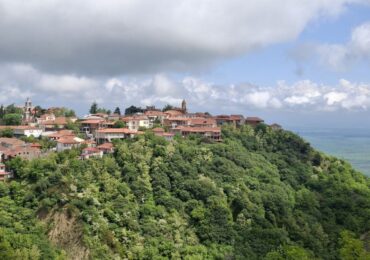Sighnaghi
Built on a hill overlooking the Alazani Valley and surrounded by a mighty wall, Sighnaghi has always been a place where love, kindness, and virtue were protected. The name of the town comes from the Turkish word ‘Siginak’, meaning shelter or sanctuary. Although the city was built by King Erekle II in the 18th century, archaeological evidence suggests that the territory was populated from the Palaeolithic age. Erekle understood the city’s spiritual and geographic importance and built the wall around it.
The Great Wall of Sighnaghi was built not only to protect the population, but also important historic and religious sights.

Colourful houses, narrow streets with cobbled roads, carved wooden balconies, wineries and restaurants have always made the town a popular destination. Sighnaghi is where St. Nino – the woman that brought Christianity to Georgia in the 4th century –lived and preached. She is buried at the nearby Bodbe Monastery. St. Nino is so important in Georgia that she is considered as Equal to the Apostles.
After a refurbishment in 2007, Sighnaghi became one of the most beautiful cities in Georgia. Due to its fusion of unique architecture, magical atmosphere, and gorgeous panoramic views across the valley to the Caucasus Mountains, Sighnaghi is known as the City of Love, where many couples choose to spend their wedding days.
What to see in Sighnaghi:
- Sighnaghi Wall – Built by King Erekle II in the 18th century around his new citadel. Currently, only a part of the wall is visible, however, its design and position is accessible through the 19th-century plans of the city. The 4km-long wall with 28 towers was mainly built with cobblestones and red bricks.
- Wine Festival – Taking place each October, one can enjoy the finest wines and delicious food from various Georgian regions, study the challenging moves of Georgian dances, or look at canvases by the local artists.
- Bodbe Monastery – one of the most important religious sites in Georgia, built on the tomb of the St. Nino the Enlightener of Georgia. The main church – the three-naved basilica – was built in the 9th century on the basis of a small church constructed by the King Vakhtang Gorgasali in the 5th St. Nino’s Spring, believed to have healing powers, is on the territory of the monastery.
- The Sighnaghi Museum – although relatively new (established in 2007), it exhibits unique pieces of archaeological relics dating as far back as the Stone Age, ethnographic treasures including musical instruments, weapons, and household items, and works by Niko Pirosmani – a renowned self-taught artist of the 19th-20th centuries, whose works are sold at Sotheby’s.
- Wandering Around the Town – gives the opportunity to experience the atmosphere to its fullest. One can encounter small house-wineries, street-food corners, and hand-made souvenir shops and stalls.
Best time to visit Sighnaghi: Late April – Mid-October.

